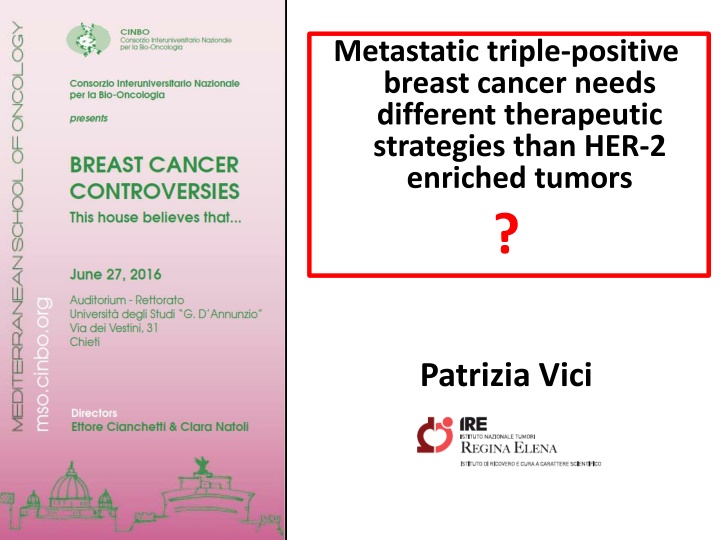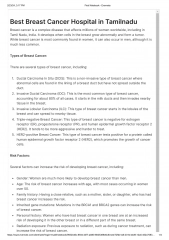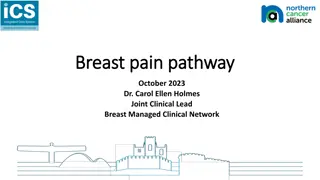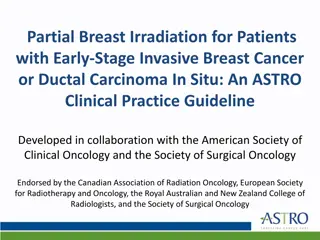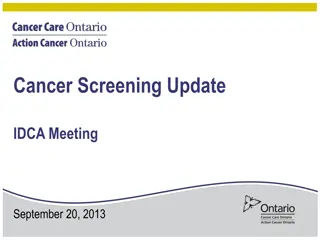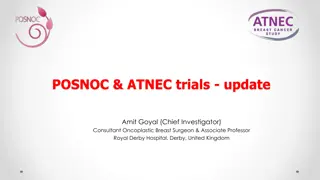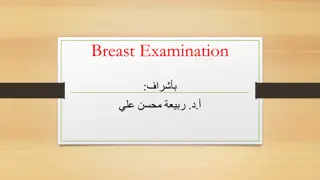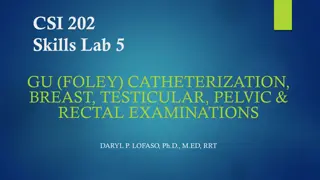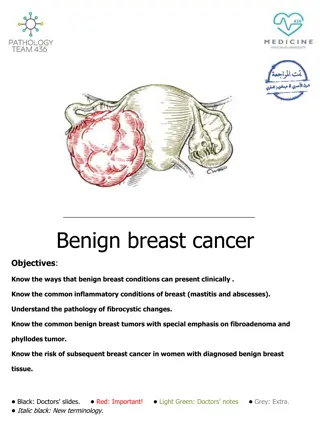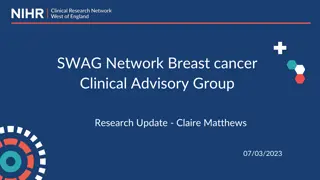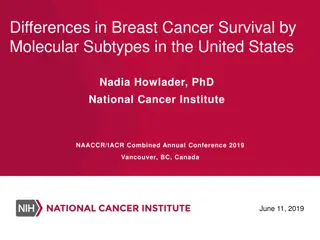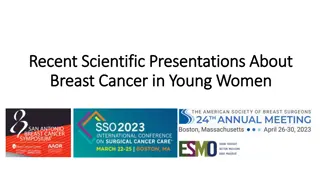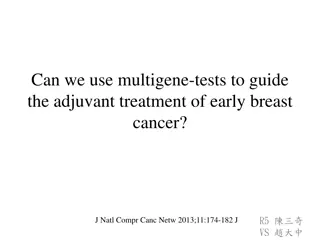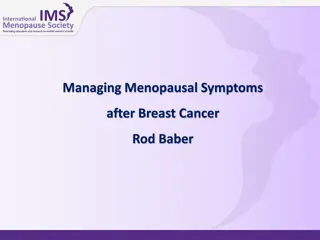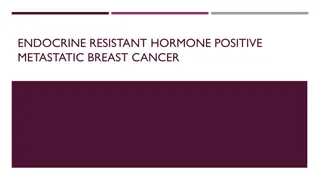Metastatic Triple-Positive Breast Cancer: Different Therapeutic Strategies
Metastatic triple-positive breast cancer necessitates distinct therapeutic approaches compared to HER-2 enriched tumors. The importance of tailored treatment strategies in addressing the complexities of different breast cancer subtypes is highlighted. Insights from studies such as Cleopatra, TDM-1: EMILIA, and TDM-1: TH3RESA shed light on the nuances of managing metastatic breast cancer, emphasizing the need for personalized care.
Download Presentation

Please find below an Image/Link to download the presentation.
The content on the website is provided AS IS for your information and personal use only. It may not be sold, licensed, or shared on other websites without obtaining consent from the author.If you encounter any issues during the download, it is possible that the publisher has removed the file from their server.
You are allowed to download the files provided on this website for personal or commercial use, subject to the condition that they are used lawfully. All files are the property of their respective owners.
The content on the website is provided AS IS for your information and personal use only. It may not be sold, licensed, or shared on other websites without obtaining consent from the author.
E N D
Presentation Transcript
Metastatic triple-positive breast cancer needs different therapeutic strategies than HER-2 enriched tumors ? Patrizia Vici
TDM-1: EMILIA (Activity HR+/HR-) Verma S ESMO 2012
TDM-1:TH3RESA Study (PFS Subgroup Analyses) By Investigator Assessment TPC T-DM1 T-DM1 Better TPC Better Baseline characteristic Total n Median (months) Median (months) n Event n Event HRa(95% CI) 602 198 129 3.3 404 219 6.2 0.52 (0.42, 0.65) All patients ER and PR status ER+ and/or PR+ ER and PR Unknown 311 270 21 103 85 10 66 58 3.9 2.9 3.9 208 185 11 109 105 5.9 6.0 8.3 0.56 0.51 0.17 (0.41, 0.76) (0.37, 0.71) (0.03, 0.93) 5 5 Disease involvement Visceral Nonvisceral 452 150 150 48 95 34 3.4 3.1 302 102 168 51 6.2 6.7 0.56 0.41 (0.44, 0.72) (0.26, 0.64) Number of prior regimens for advanced BC 209 214 177 78 65 55 49 45 35 3.3 3.7 2.9 131 149 122 60 83 75 6.9 6.2 5.8 0.48 0.58 0.48 (0.32, 0.70) (0.40, 0.83) (0.32, 0.73) 3 4 5 >5 Brain metastasis at baseline Yes No 67 27 16 2.9 3.6 40 24 5.8 6.2 0.47 0.53 (0.24, 0.89) (0.42, 0.66) 535 171 113 364 195 0.2 0.5 1 2 5 aUnstratified HR. Krop I et al Lancet Oncol 2014
Her2+ Small but signif. advantage Eve: less efficacy in HR+(Her2+)
Her2+ No differences Eve: benefit in HR- (Her2+)
At least two types of genetic HER2+ tumours The Cancer Genome Atlas Network, Nature 2012
Her-2 heterogeneity IHC Cancer Genome Atlas + Metabric datasets Subtype is more informative than HER2-status on breast cancer specific DFS Prat et al JNCI 2014
Eterogeneit clinica dei tumori HER2 + Prat et al JNCI 2014
Cross talk and resistance to endocrine therapy Tamoxifen Ais Fulvestrant? HER1/HER2 Alteration ER Direct ER phosphorilation Recruitment of co-activators Repression or ER functions Repression of ER synthesis Tumor cell proliferation
Crosstalk to explain resistance to HER2- inhibitors Trastuzumab Lapatinib Pertuzumab HER2 Alteration ER - Repression of HER2 synthesis - Escape through ER Tumor cell proliferation
ER-HER2 crosstalks Miller T W et al. JCO 2011;29:4452-4461
ER and HER2 simultaneous targeting Trastuzumab Lapatinib Pertuzumab Tamoxifen Ais Fulvestrant? HER2 Alteration ER Tumor Cell Death
HER2-positive breast cancer cells that become resistant to Lapatinib upregulate ER-related genes Xia et al PNAS 2006
Triple positive BC (ER+/PgR+/Her2+)
Breast Cancer Subtypes: 21% Her-2 positive N=114,786 ~21% HER2+ ~79% HER2- 7.1% Triple positive 10.8% Breakdown of the 21% HER2+ 3.3% ER+/PR+/HER2+ ER+/PR-/HER2+ 0.5% ER-/PR+/HER2+ ER-/PR-/HER2+ Bauer K., Cancer. 2010;10:228. 21 21
Her-2+/HR+ Even double-block works less in ER+ ??? Trastuzumab benefit less impressive ? [TITLE] Less pCR
pCR rates according to ER status in neoadjuvant trials Author Treatment ER- ER+ T + Pacli 36.5 22.7 Baselga NEO-ALTTO L + Pacli 33.8 16.2 T+L + Pacli 61.3 41.6 T + Doce 36.8 20.0 Gianni NEO-Sphere P + Doce 30.0 17.4 T + P + Doce 63.2 26.0 T + P 29.1 5.9 Chang (ASCO 2011) T + L (+ Let) 40.0 21.0 T, trastuzumab; L, lapatinib; P, pertuzumab; Pacli, paclitaxel; Doce, docetaxel; Let, letrozole
[TITLE] pCR: less predictive value (EFS) Her2+/ER+ tumors
Prognostic impact of pCR on DFS according to breast cancer intrinsic subtype no yes no Luminal A Luminal B HER2 pos Luminal B HER2 neg yes yes HER2 positive Triple neg von Minckwitz G et al J Clin Oncol 2012
Different OS according to HER2+subtype ER/PgR/HER2+ better OS Parise CA et al Cancer Epidemiol 2014
3,394 Her-2 positive pts Timing of recurrence 2000-2007(44% treated with neoad/adj trastuz) Recurrence : 45% HR+, 55% HR- Recurrence beyond 5yrs: 66% HR+ vs 34% HR neg HR+ HR- OS by HR status Curves tend to converge (late recurrences?)
Metastatic Behavior of Breast Cancer Subtypes Frequency among pts who developed mts(%) Brain Liver Lung Bone Distant Nodes 15.9 Pleura /peritoneum 28.2 Luminal A 7.6 28.6 23.8 66.6 Luminal B 10.8 15.4 32.0 44.4 30.4 36.8 71.4 65.0 23.3 22.2 35.2 34.2 Luminal/HER2 HER2 enriched 28.7 45.6 47.1 59.6 25.0 31.6 Basal Like 25.2 21.4 42.8 39.0 39.6 29.6 TN non basal 22.0 32.1 35.8 43.1 35.8 28.4 Pearson s Chi-square test showed p <0.001 in all cases H Kennecke, JCO 2010
Montemurro, Cancer 2012 Quantitative expression of HRs may influence response rate to trastuzumab and chemotherapy Receptor positivity Number CR + PR SD+PD P value* (%) (%) (%) ER 0-29% 140 (66) 95 (68) 45 (32) 0.032 30-100% 72 (34) 38 (53) 34 (47) PgR 0-49% 195 (92) 126 (65) 69 (35) 0.055 50-100% 17 (8) 7 (41) 10 (59) Multivariate Odds Ratio of response in tumors expressing ER in 30% of cells 0.422, 95% C.I. 0.222-0.803, p = 0.009
Maintenance endocrine therapy added to HER2- targeting Group HR 95% C.I. P ER<30% 1 PFS ER 30% No-HT 0.747 0.516-1.081 0.122 ER 30% + HT 0.502 0.313-0.807 0.004 ER 30% and HT ER 30% No-HT ER<30 Montemurro, Cancer 2012
HR expression degree ???
??? Da tutte queste informazioni siamo autorizzati ad omettere la chemioterapia nelle pazienti HER2+/HR+ ???? a) In adiuvante/neoadiuv.: no al di fuori studi b) In fase avanzata ????
TAnDEM study design Anastrozole 1 mg daily + Trastuzumab 4 mg/kg loading dose 2 mg/kg qw until disease progression HER2-positive, HR-positive MBC (n=208) R Anastrozole 1 mg daily until disease progression Crossover to receive trastuzumab was actively offered to all patients who progressed on anastrozole alone Kaufman et al, J Clin Oncol 27, 5529, 2009
Phase III, Randomized, Double-Blind Controlled Trial: Study Design N=1286 (including n=219 HER2+) Patient Population ER+ and/or PgR+ Postmenopausal HER2+ , HER2-ve / Unknown Stage IIIb/IIIc/IV No prior treatment for MBC R A N D O M I Z E Letrozole 2.5 mg daily + Placebo Stratification Disease sites Bone only / visceral or soft tissue Interval since adjuvant tamoxifen therapy < 6 mo / 6 mo or none Letrozole 2.5 mg daily + Lapatinib 1500 mg daily Johnston et al, J Clin Oncol 27;5538, 2009
HER2 inhibition restores an endocrine sensitive status? Study Treatment N ORR (%) PFS (mo) OS Anastrozole 104 6.8 2.4 23.9 TANDEM Anastrozole + trastuzumab 103 20.3* 4.8* 28.5 Letrozole + Placebo 108 15 3 32.3 EGF30008 Letrozole + Lapatinib 111 28* 8.2* 33.3 Letrozole 31 13 3.3 NR eLEcTRA Letrozole + Trastuzumab 26 27 14.1 NR
Ongoing studies without chemo in HR+/Her2+ tumors PER ELISA (neoadjuvant) ADAPT (neoadjuvant) HERLAP 2 (advanced) PERTAIN (advanced)
HERLAP 1 study outline Trastuzumab 8 mg/kg loading 2 mg/kg/week Patients with FISH-proven HER2-positive low-burden advanced disease, No prior treatment for ABC 8 wks CR PR MR Random Lapatinib 1500 mg/die os T or L + Chemo SD PD No other concomitant treatment Target accrual 120 patients (->19) Extensive immunohistochemical and cytogenetic analyses
HERLAP main results Her2 enriched more sensitive to trast/Lap than luminal Her2: different tumors
HERLAP2 study design Hormone therapy if triple positive Patients with FISH-proven HER2-positive low-burden advanced disease, No prior treatment for ABC Trastuzumab 4 mg/kg loading 2 mg/kg/week 8 wks CR PR MR Lapatinib 1000 mg/die os T + L + Chemo SD PD (qwpacli, trast and L reduced to 750/day) Target accrual 60 patients Meticulous tumor sample collection Plasma
RFS 5yr RFS 5yr OS OS 925 Her2+ pts 925 pts Her2 +
RFS/OS by HRs RFS OS
..brain storming.. Triple positive early breast cancer Retrospective analysis: 872 TP early BC from 19 italian oncologic centres Cohort A: chemotherapy (-> endocrine therapy) Cohort B: chemotherapy + trastuzumab (-> endocrine therapy
Cohort A: only CT Cohort B: CT+Trast Overall
overall TP50 Curves tend to . late recurrences .. No-TP50 Red: only CT Blu: CT+Trast
ER ER levels PgR
